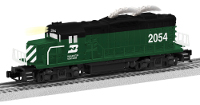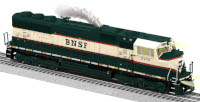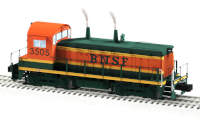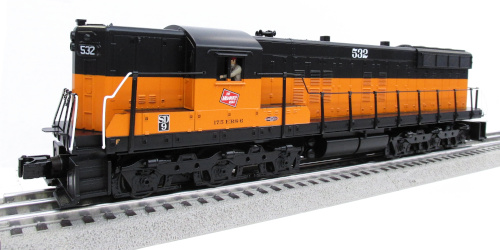
Information and Orders: 1-406-259-9004
Hours: Mon - Sat 10-6 MST
Central Hobbies
1401 Central Avenue
Billings, MT 59102
We Gladly Accept:

as well as

TRAINS : O-GAUGE LOCOMOTIVES
- Page 1 of 2 | 17 Total Products

MTH O Gauge RailKing SD-9 Diesel Engine w/Proto-Sound 3.0
Description:
In the General Motors' Electro-Motive Division time line, 1954 holds significance for two important events. In that year, the manufacturer produced its 15,000th locomotive and introduced the 1,750-h.p. SD9. The road switcher was produced until 1959. Basically an elongated — and, some might say, handsomer — version of EMD’s very popular GP9, the SD9 spread the same horsepower over two additional axles, resulting in a lower loading on each axle. This made the engine more suitable for use on light rail and in situations requiring power at low speeds, such as hump yard service.
The RailKing Scale model of the SD9 is built to 1/48th scale proportions and is thus somewhat larger than typical RailKing diesels. O gauge operators looking for scale proportioned locomotives will find durable, yet well detailed, RailKing Scale models to be an excellent alternative to more expensive O scale diesels.
Did You Know?
A special version of the SD9, the SD9s, was a lightweight locomotive used primarily for branchline service.
- Intricately Detailed, Durable ABS Body
- Die-Cast Truck Sides, Pilots and Fuel Tank
- Metal Chassis
- Metal Handrails and Horn
- (2) Handpainted Engineer Cab Figures
- Authentic Paint Scheme
- Metal Wheels, Axles and Gears
- (2) Remote-Controlled Proto-Couplers
- Prototypical Rule 17 Lighting
- Directionally Controlled Constant Voltage LED Headlight
- Illuminated LED Number Boards
- (2) Precision Flywheel-Equipped Motors
- Operating ProtoSmoke Diesel Exhaust
- Onboard DCC/DCS Decoder
- Locomotive Speed Control In Scale MPH Increments
- 1:48 Scale Proportions
- Proto-Sound 3.0 With The Digital Command System Featuring Freight Yard Proto-Effects
- Unit Measures: 16” x 2 3/4” x 4”
- Operates On O-31 Curves
Our Price: $369.95

LIONEL Burlington Northern LionChief Plus 2.0 GP20 Locomotiv
Description:
Seen on the rails form 1959 through 1962, these turbocharged engines opened the door to a new generation of diesel locomotive. Available in four popular road names and equipped with our LionChief Plus 2.0 technology, these colorful engines are ready to take your layout to the next level of operation.
- Command-control equipped - Operate via Bluetooth using Universal Remote or LionChief App, via Command Control using TMCC or LEGACY Cab, via conventional transformer, or lash-up with similar LCC locomotives in Command Control
- Speed control
- Railsounds equipped - Diesel engine and background sounds, Horn, Bell, Crewtalk / Towercom dialog
- Lionel Voice Control (LVC) – run your locomotive by speaking commands into your phone via LionChief App
- Fan-driven smoke
- On/Off switch for smoke
- Dual ElectroCouplers ™
- Dual-powerful maintenance free motors
- Die-cast trucks, pilot and fuel tank
- Metal frame
- Directional Headlights
- Cab illumination

Our Price: $499.99

MTH O Scale Premier SD45 Low Hood Diesel Engine w/Proto-Soun
Description:
MONTANA RAIL LINK SD45
MTH's Premier model of this heavy hauler offers an outstanding combination of detail, realism, and performance. Added-on detail parts include windshield wipers, lift rings, metal grab irons and handrails, see-thru rooftop fan housings, and walkways with safety tread. Thanks to Proto-Speed Control, this model can dig in and haul long trains at any speed from a crawl to full throttle. And in command mode with the DCS system, you can create a lashup combining one or more SD45s with any other Proto-Sound 3.0 locomotives, and run them all from a single throttle just like the prototype.
-500.jpg)
Our Price: $419.95

MTH O Gauge RailKing ES44AC Imperial Diesel Engine With Prot
Description:
With a wave of consolidation behind it, North American railroading is once again a good business to be in. Freight traffic is booming. Locomotive orders are coming in at a record pace from the Big Six roads that dominate rail transportation on the continent: Union Pacific, BNSF, CSX, Norfolk Southern, Canadian National, and Canadian Pacific. And the two remaining diesel builders are locked in a battle to become the locomotive supplier for the 21st century. Caterpillar®-owned EMD, no longer a divison of General Motors, is represented by the AC-traction-motored SD70ACe and its DC-traction sibling, the SD70M-2. General Electric’s standard bearers are the EVOs, the Evolution Series ES44AC and ES44DC.

Our Price: $399.99

MTH O Scale Premier SD24 Diesel Engine w/Proto-Sound 3.0
Description:
In 1958, GM's Electro-Motive Division took a great technological stride forward with the introduction of the turbocharged SD24. In turbocharged engines, exhaust gases are used to power a turbine that increases cylinder air pressure, thus effectively increasing horsepower. In fact, the 16-cylinder model 567 diesel that produced 1800 horsepower in the normally aspirated SD18 locomotive was upgraded to 2400 horsepower in the turbocharged SD24.
Turbocharged engines also run better at varying altitudes, making them ideal for railroads that travel through changing terrain. Look on the left side of the SD24's hood for the semicircular bulge that marks the location of the turbine.
The SD24s were close relatives of the popular GP-series engines. The primary difference was that SD-series (for "Special Duty") locomotives were lengthened to make room for three-axle, three-motor trucks. For a GP and an SD engine of the same horsepower, the extra wheels on an SD locomotive gave it more tractive effort at low speeds and less engine weight on each axle. For this reason, the SD24 and others in the SD series were ideally suited for secondary lines with lighter rail.

Our Price: $559.99

MTH O Scale RailKing FP45 Diesel Engine With Proto-Sound 3.0
Description:
- Intricately Detailed, Durable ABS Body
- Die-Cast Truck Sides, Pilots and Fuel Tank
- Metal Chassis
- Metal Handrails and Horn
- (2) Handpainted Engineer Cab Figures
- Colorful Paint Scheme
- Metal Wheels, Axles and Gears
- (2) Remote-Controlled Proto-Couplers
- Prototypical Rule 17 Lighting
- Directionally Controlled Constant Voltage LED Headlights
- (2) Precision Flywheel-Equipped Motors
- Operating ProtoSmoke Diesel Exhaust
- Onboard DCC/DCS Decoder
- Locomotive Speed Control In Scale MPH Increments
- 1:48 Scale Proportions
- Proto-Sound 3.0 With The Digital Command System Featuring Freight Yard Proto-Effects
- Unit Measures: 18 1/2” x 2 9/16” x 4”
- Operates On O-31 Curves Diesel DCC Features

Our Price: $429.99

MTH O Scale RailKing Dash-8 Diesel Engine With Proto-Sound 3
Description:
MTH O Scale RailKing Dash-8 Diesel Engine With Proto-Sound 3.0
- Intricately Detailed, Durable ABS Body
- Die-Cast Truck Sides, Pilots and Fuel Tank
- Metal Chassis
- Metal Handrails and Horn
- (2) Handpainted Engineer Cab Figures
- Authentic Paint Scheme
- Metal Wheels, Axles and Gears
- (2) Remote-Controlled Proto-Couplers
- Prototypical Rule 17 Lighting
- Directionally Controlled Constant Voltage LED Headlights
- Lighted LED Cab Interior Light
- Illuminated LED Number Boards
- Operating LED Ditch Lights
- (2) Precision Flywheel-Equipped Motors
- Operating ProtoSmoke Diesel Exhaust
- Onboard DCC/DCS Decoder
- Locomotive Speed Control In Scale MPH Increments
- 1:48 Scale Proportions
- Proto-Sound 3.0 With The Digital Command System Featuring Freight Yard Proto-Effects
- Unit Measures: 18 1/2 x 2 5/8 x 3 7/8
- Operates On O-31 Curves Diesel DCC Features

Our Price: $419.95

LIONEL O GUAGE BNSF LEGACY SD70MAC #9789
Description:
LEGACY® Control System equipped – able to run in LEGACY® Control mode, in TrainMaster Command Control mode, or in Conventional mode with a standard transformer
Bluetooth® Control - Operate with Universal
Remote or LionChief® App
Lionel Voice Control (LVC) - run your locomotive by speaking commands into your phone via LionChief® App
Odyssey® II Speed Control
IR Transmitter that works with LCS
SensorTrack™
Powerful maintenance-free motor with momentum flywheel
ElectroCoupler™ on rear
Directional lighting including operating headlight and back-up light on rear of tender
Bi-color class/marker lights - Using a Legacy controller, change the color of the classification lights between white or green
Traction tires
Interior illumination in cab
Die-cast metal locomotive body, pilot, and trucks
Die-cast metal tender body and trucks
High level of separately applied metal details
Separately applied builder's plate
Synchronized fan-driven smoke unit
Fan driven stack smoke and whistle steam
Adjustable smoke output
Authentically detailed cab interior
Cab "glass" windows
Engineer and fireman figures

Our Price: $649.99

MTH O MRL FP45 diesel loco Proto-Sound 3.0
Description:
O gauge Montana Rail Link FP45 locomotive with Proto-Sound 3.0
- Intricately Detailed, Durable ABS Body
- Die-Cast Truck Sides, Pilots and Fuel Tank
- Metal Chassis
- Metal Handrails and Horn
- (2) Handpainted Engineer Cab Figures
- Colorful Paint Scheme
- Metal Wheels, Axles and Gears
- (2) Remote-Controlled Proto-Couplers
- Prototypical Rule 17 Lighting
- Directionally Controlled Constant Voltage LED Headlights
- (2) Precision Flywheel-Equipped Motors
- Operating ProtoSmoke Diesel Exhaust
- Onboard DCC/DCS Decoder
- Locomotive Speed Control In Scale MPH Increments
- 1:48 Scale Proportions
- Proto-Sound 3.0 With The Digital Command System Featuring Freight Yard Proto-Effects
- Unit Measures: 18 1/2” x 2 9/16” x 4”
- Operates On O-31 Curves Diesel DCC Features
- F0 Head/Tail light

Our Price: $429.95

LIONEL BNSF LEGACY SW1200 #3505
Description:
EMD's SW1200, and its identical cousins the SW7 and SW9, have been a part of the railroad scene for 70+ years! From branch line freight trains to switchyards to mills, these switchers can still be found hard at work nationwide. The SW1200 shares the same great details as our SW7 and SW8 releases. Featuring a single motor drive, both LEGACY and Bluetooth control, RailSounds and fixed pilots, these versatile locomotives offer tremendous features and detail in a compact model. They will be right at home switching cars or hauling freight on railroads of any size!
LEGACY® Control System equipped – able to run in LEGACY® Control mode, in TrainMaster Command Control mode, or in Conventional mode with a standard transformer
Bluetooth® Control - Operate with Universal
Remote or LionChief® App
Lionel Voice Control (LVC) - run your locomotive by speaking commands into your phone via LionChief® App
Odyssey® II Speed Control
IR Transmitter that works with LCS
SensorTrack™
Powerful maintenance-free motor with momentum flywheel
Wireless Tether™ connection between locomotive and tender
ElectroCoupler™ on rear of tender
Directional lighting including operating headlight and back-up light on rear of tender
Bi-color class/marker lights - Using a Legacy controller, change the color of the classification lights between white or green
Traction tires
Interior illumination in cab
Die-cast metal locomotive body, pilot, and trucks
Die-cast metal tender body and trucks
High level of separately applied metal details
Separately applied builder's plate
Synchronized fan-driven smoke unit
Fan driven stack smoke and whistle steam
Adjustable smoke output
Authentically detailed cab interior
Cab "glass" windows
Engineer and fireman figures
LEGACY® RailSounds® sound system featuring:
CrewTalk™ dialog with different scenarios depending on whether the locomotive is in motion or stopped
TrainSounds that mimic operating dialog when the locomotive is in motion or stopped
Six official railroad speeds with CrewTalk dialog
DynaChuff™ synchronized with 32 levels of intensity as the locomotive gains speed
LEGACY® "Real-Time Quilling Whistle" control with instant response for realistic signature "quilling" and correctly timed warning signals - 5 different whistles to choose from for a more customized experience
Single hit or continuous mechanical bell sounds - 5 levels of bell pitching for customized sounds
Sequence Control: plays the sound effects of an entire trip, including warning sounds and announcements, based on the movement and speed of the locomotive
Current speed and fuel dialog, coal or oil loading sound effects
Road number specific crew talk

Our Price: $549.99

O Gauge RailKing RS-3 Diesel Engine With Proto-Sound 3.0
Description:
This product is compatible with all O Gauge 3-Rail track systems including those systems offered by Atlas and Gargraves and Lionel and Ross Custom Switches.
- Intricately Detailed, Durable ABS Body
- Die-Cast Truck Sides, Pilots and Fuel Tank
- Metal Chassis
- Metal Handrails and Horn
- Authentic Paint Scheme
- Metal Wheels, Axles and Gears
- (2) Remote-Controlled Proto-Couplers
- Prototypical Rule 17 Lighting
- Directionally Controlled Constant Voltage LED Headlights
- (2) Precision Flywheel-Equipped Motors
- Operating ProtoSmoke Diesel Exhaust
- Onboard DCC/DCS Decoder
- Locomotive Speed Control In Scale MPH Increments
- 1:48 Scale Proportions
- Proto-Sound 3.0 With The Digital Command System Featuring Freight Yard Proto-Effects
- Unit Measures: 14 1/2” x 2 1/2” x 3 3/4”
- Operates On O-27 Curves Diesel DCC Features

Our Price: $359.95

MTH O Scale Premier SD-35 Diesel Engine w/Proto-Sound 3.0 (H
Description:
While the MTH Premier model is not the first O gauge version of this heavy hauler, it offers the best combination of detail, realism, and performance of any 1/48 scale SD35. Added-on detail parts include windshield wipers, metal see-thru body grilles, lift rings, metal grab irons and handrails, see-thru rooftop fan housings, and truck-mounted brake cylinders and air pipes. Thanks to Proto-Speed Control, this model can dig in and haul heavy loads at low speeds just like the prototype, or highball down the mail line with a fast freight. And in command mode with the DCS system, you can create a lashup combining one or more SD35s with any other Proto-Sound 2.0 and 3.0 locomotives, and run them from a single throttle just like the prototype.

Our Price: $579.95
- Page 1 of 2 | 17 Total Products
